Blog
Vultures: Nature’s cleanup crew and wildlife detectives
Read moreAfrican animals with horns: facts and photos
Between antelopes, buffalo, and rhinos, there is a wide variety of animals in Africa that have horns. It can sometimes be tricky to tell them apart from each other—but if you’ve ever wondered what’s the difference between a gazelle and an antelope, or if the okapi is related to zebras, we have the answers for you.
Here is a list of some of the most fascinating animals in Africa that have horns, from the tiny royal antelope to the massive white rhino. Not all these horned animals are mammals—some reptiles in Africa are known to have horns, too, including the Saharan horned viper and Jackson’s horned chameleon.
Sadly, much of Africa’s biodiversity is threatened by issues like poaching, drought, and habitat loss. As a conservation and rescue organisation, IFAW is working in Africa and around the world to mitigate these threats and protect wildlife. Learn more about our work or how you can get involved.
Read on to learn interesting facts and see photos of these amazing African animals.
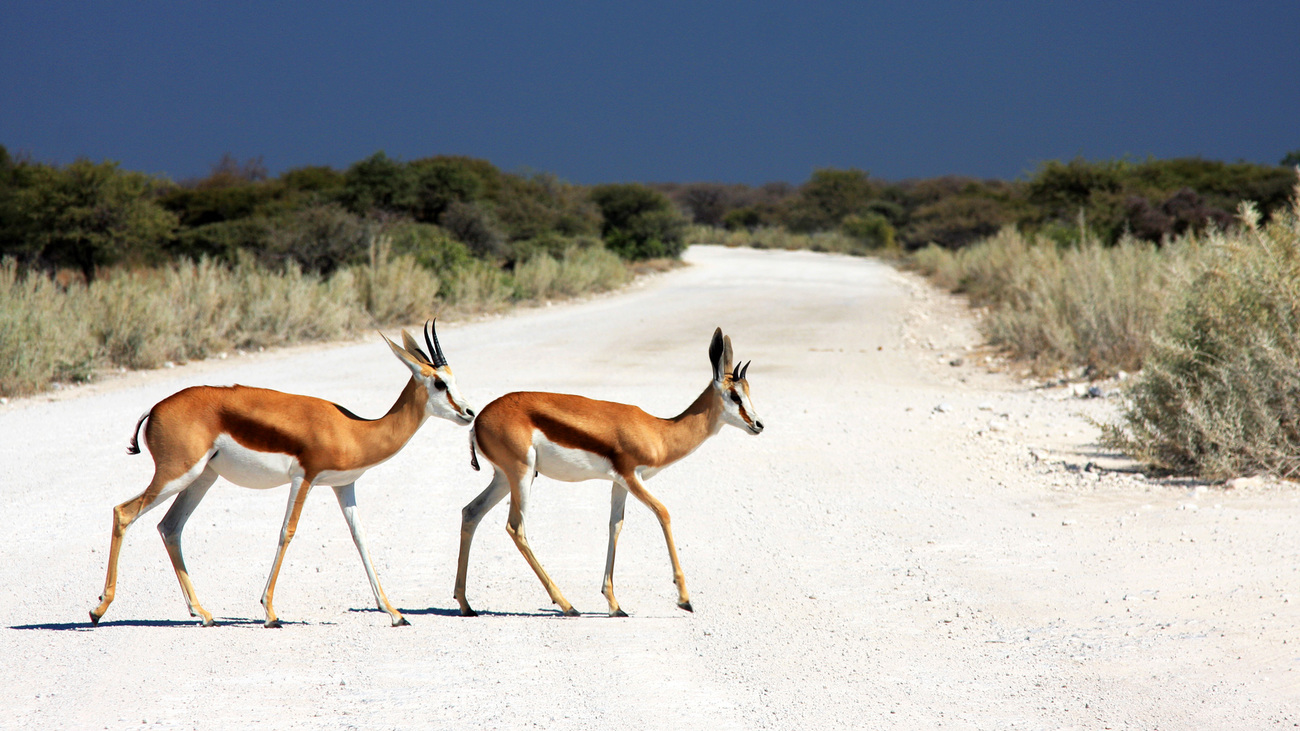
Also known as the springbuck, the springbok (Antidorcas marsupialis) is an antelope species found in southern Africa. Springboks are slim and long-legged, with light brown coats, white undersides, and white faces with black stripes running from their eyes to their mouth.
Male and female springboks both have long, dark horns, which point backwards and curve toward each other at the tips, almost looking like they form a heart shape. The International Union for the Conservation of Nature (IUCN) categorises springboks as least concern.
Oryx (genus Oryx) are large antelopes recognised by the dark markings on their faces and legs. There are four species of oryxes: the Arabian oryx (Oryx leucoryx), scimitar oryx (Oryx dammah), East African oryx (Oryx beisa), and South African oryx (Oryx gazella). Except the scimitar oryx, all oryx species have long, backwards-pointing horns that are almost perfectly straight. The scimitar oryx also lacks dark markings and has a very pale coat, aside from the tan colour around its neck. Both male and female oryxes have permanent horns.
The scimitar oryx is found in North Africa, and the IUCN classes it as endangered. There are only 140 to 160 scimitar oryx remaining in the wild, largely due to poaching.
The East African oryx, also known as the beisa, is endangered. This species is also frequently hunted. The Arabian oryx is classed as vulnerable, and the South African oryx—also known as the gemsbok—as least concern.
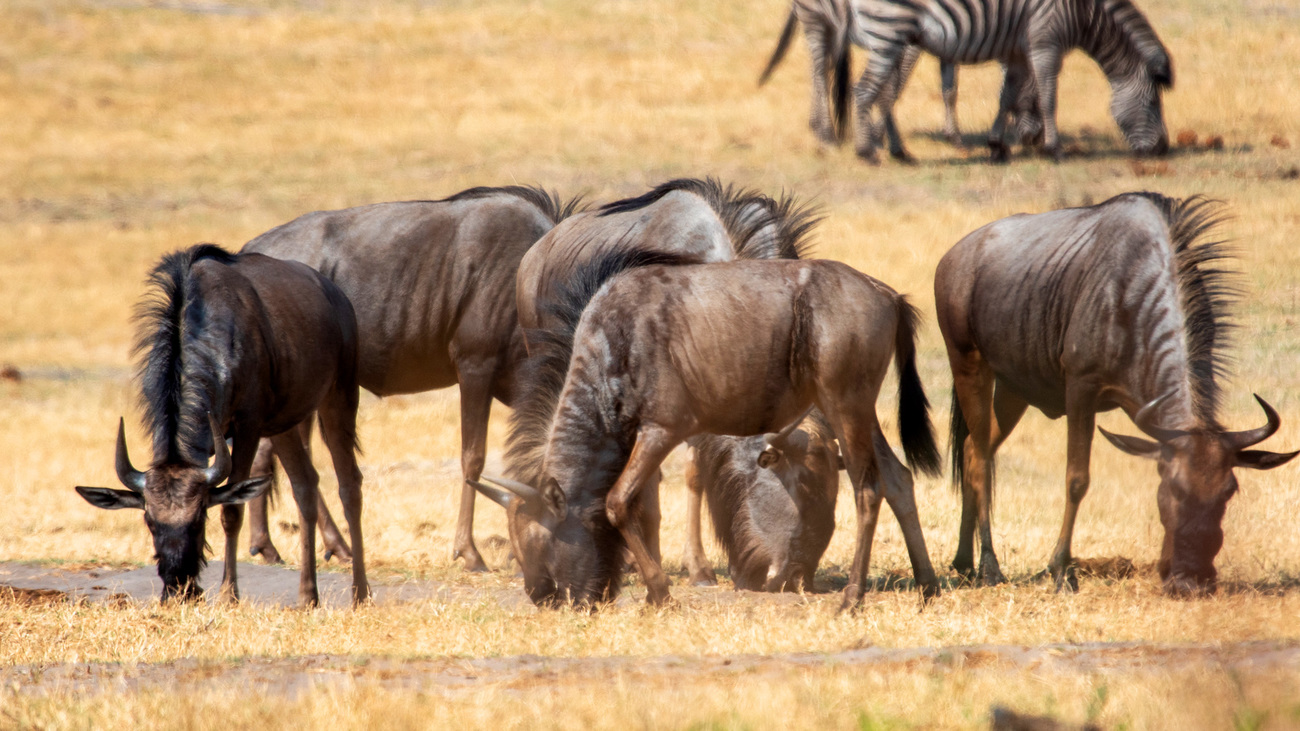
Also known as gnus, wildebeests (genus Connochaetes) are large, hoofed mammals with dark coats. Both male and female wildbeeests have horns. Wildebeests have high, sloping shoulders with a hump, short necks, manes, and beards.
There are two wildebeest species, the common wildbeest (Connochaetes taurinus) and the black wildbeest (Connochaetes gnou). The common wildebeest’s horns point out to the sides and curve upwards, towards each other. The black wildebeest’s horns point more towards the front and also curve upwards. Both species are found in southern Africa, and the common wildebeest is also found in parts of East Africa. The IUCN categorises both species as least concern.
Elands (genus Taurotragus) are the largest antelopes in the world. There are two species, the smaller common eland (Taurotragus oryx) and the larger giant eland (Taurotragus derbianus). Both males and females have horns that are straight and point backwards with spiral ridges. Female common elands have larger horns than males, but males’ horns are thicker. Male elands have prominent dewlaps—loose flaps of skin that hang down from their necks.
The common eland, found across southern, Central, and East Africa, is classed by the IUCN as least concern. The giant eland is classed as vulnerable and is found in small pockets of Central and West Africa.
Also known as the kogoni or kaama, the hartebeest (Alcelaphus buselaphus) is a large antelope with horns that protrude diagonally upwards, curve forward, and then curve backwards at the tips, giving them a hooked appearance. Their coats are light tan to chocolate brown in colour. Both male and female hartebeests have these oddly-shaped horns.
Hartebeests are found across sub-Saharan Africa, and the IUCN classes them as least concern. However, their population is decreasing, and they have gone extinct in North Africa and the Middle East, where they once roamed.
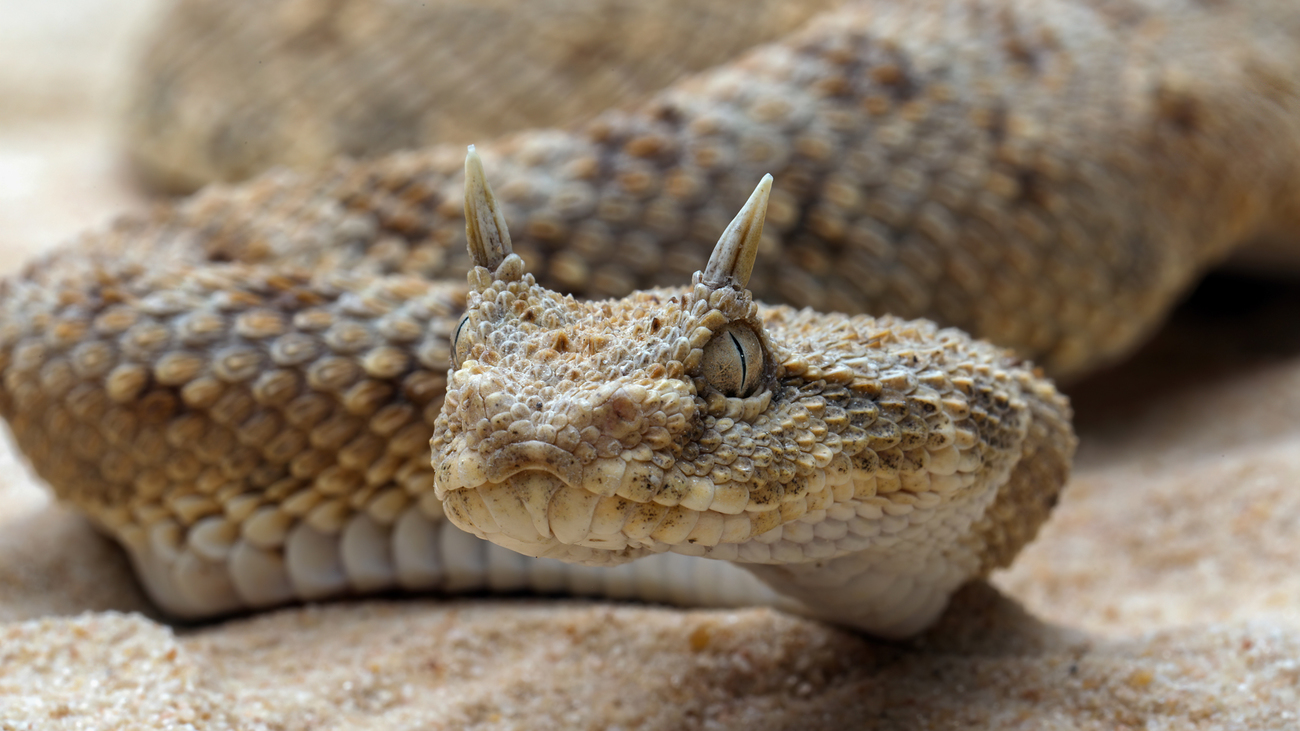
Saharan horned vipers (Cerastes cerastes) are sand-coloured snakes found in the deserts of North Africa and parts of the Arabian Peninsula. Above their eyes, they have ‘horns’ made of large, pointed scales above their eyes. However, some Saharan horned vipers are born without this feature.
The IUCN classes Saharan horned vipers as least concern, and though they have no major threats to their survival, they are sometimes captured for local exhibition or to extract their venom.
Also known as the red lechwe, the southern lechwe (Kobus leche) is a reddish-brown antelope found in the wetlands of south-central Africa. Only male southern lechwes have horns, which are very long and spiral-ridged. They point backwards and then curve upwards.
Southern lechwes are classed as near threatened by the IUCN and have a declining population. They’ve been eliminated from large portions of their range due to poaching.

Rhinos are some of the largest land animals on Earth, and the rhinos of Africa possess two horns on top of their noses—one large and one small. The two African rhino species are the white rhino (Ceratotherium simum) and black rhino (Diceros bicornis), which are actually both grey. Male rhinos are territorial and use their horns in fights to determine the dominant male. Female rhinos also have horns.
All rhino horns are made of keratin, the same material as human hair and fingernails. However, their horns are considered valuable in many countries and are trafficked in the ivory trade. Poaching has led to the near extinction of the critically endangered black rhino and northern white rhino subspecies.
IFAW is dedicated to protecting rhinos in Africa. We support teams of rangers who work to prevent wildlife crime like poaching across the continent. At a policy level, we advocate for the legal protection of rhinos and work to reduce demand.
The Nile lechwe (Kobus megaceros) is an endangered antelope species found in South Sudan and Ethiopia. This species exhibits extreme sexual dimorphism, meaning males and females look very different. Males have very dark coats save for white patches around their eyes and on the back of their necks, while females are golden brown. Only male Nile lechwes have horns, which grow up and backwards, and then curve downwards before curving back up at the tips—forming a sideways S-shape.
The IUCN classes the Nile lechwe as endangered with a decreasing population. It has sadly been severely impacted by civil conflict in its range, hunting for its meat, and encroachment into its habitat by cattle farms.
The lesser kudu (Tragelaphus imberbis) is a medium-sized antelope with distinctive white vertical stripes found in East Africa. Females’ coats are golden brown, while males’ coats are dark grey. Only male lesser kudus have horns, which are tall, spiral-ridged, and make twists as they point back and upwards. The IUCN classes the lesser kudu as near threatened, and it has a declining population.
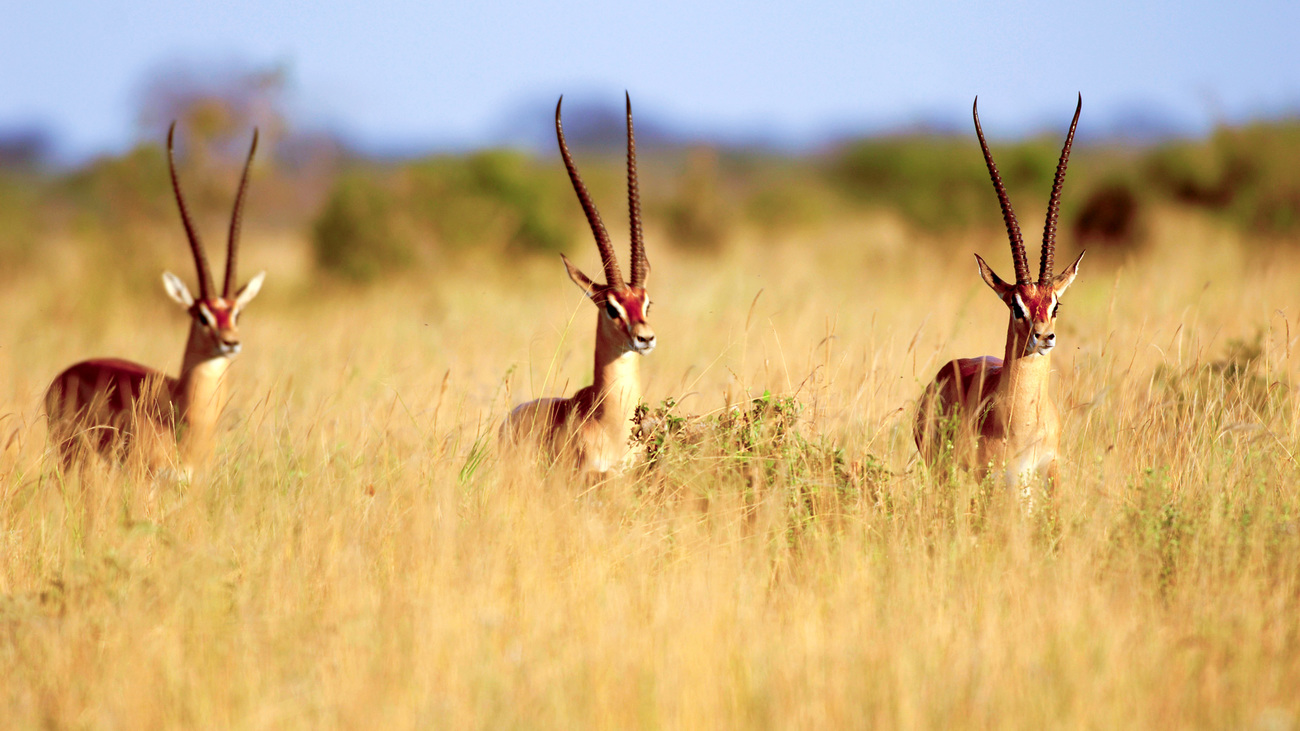
Gazelles are a type of antelope that includes all species in the genera Gazella, Eudorcas, and Nanger. Two well-known gazelles found in East Africa are Thomson’s gazelles (Eudorcas thomsonii)—known colloquially as ‘tommies’—and Grant’s gazelles (Nanger granti).
Thomson’s gazelles have light brown coats with dark stripes running along their sides and white underbellies. Male Thomson’s gazelles have thin, ridged horns that point backwards and are mostly straight, but curve forward a bit at the tips. Thomson’s gazelles are classed as least concern by the IUCN, but their numbers are declining. Climate change-induced droughts pose a major threat to these animals.
Grant’s gazelles look similar, but they often do not have dark markings on their sides, and instead they have white fur on their rumps. Grant’s gazelles also have much longer horns than Thomson’s gazelles, and they are curved in a lyre shape. Females have shorter and thinner horns, and the oldest males have the thickest horns. The IUCN classes Grant’s gazelles as least concern, but they also have a declining population and experience similar threats.
Also known as the Ethiopian ibex, the walia ibex (Capra walie) is a wild goat species found only in a small part of northern Ethiopia. Males have large, thick horns which curve backwards and down; they use these horns for disputes to determine who is the dominant male. Female walia ibex have horns that are much shorter and thinner.
The IUCN classes the walia ibex as vulnerable, and there are only about 585 individuals remaining. Habitat destruction and livestock grazing are two of the primary threats to walia ibex.
The bontebok (Damaliscus pygargus) is an antelope found in South Africa, Lesotho, and Namibia, recognisable by its chocolate-brown coat and the white fur on its face, rump, and belly.
Both male and female bonteboks have ridged, backwards-growing horns that are slightly curved downwards and then upwards at the tips.
The IUCN classes this species as least concern. However, hybridization between the bontebok and the closely related blesbok is threatening their survival.
The bongo (Tragelaphus eurycerus) is a large antelope found in forests of West and Central Africa. They have bright reddish-brown coats with thin, white vertical stripes. Both males and females have long, smooth horns that spiral inwards. Their horns appear quite different from the horns of other antelopes because of their lighter colour and lack of prominent ridges. Bongos have stout bodies and a line of longer hair running along the top of their backs.
The IUCN classes the bongo as near threatened, and it has a decreasing population. The primary threats to the bongo’s survival include habitat destruction due to illegal logging and commercial forestry as well as hunting for their meat and as trophies.
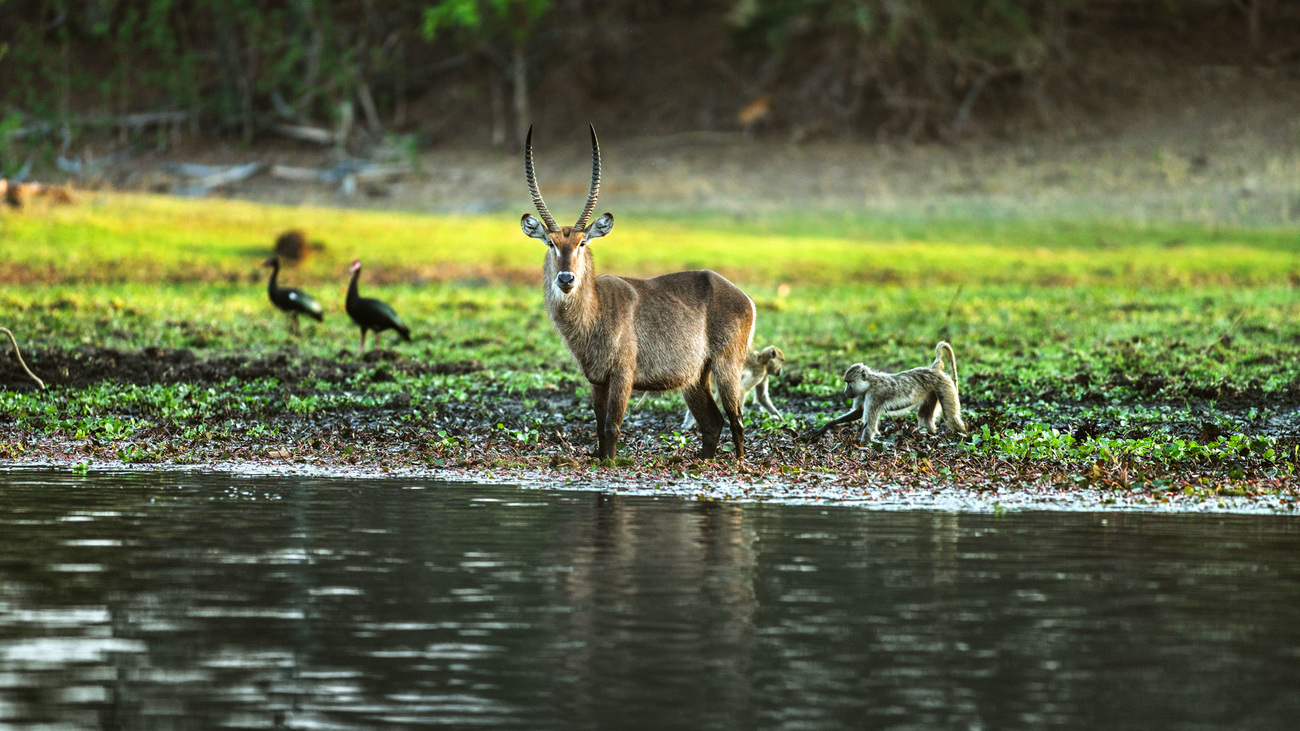
The waterbuck (Kobus ellipsiprymnus) is a large antelope with a dark, shaggy coat, found across sub-Saharan Africa. Only male waterbucks have horns, though females sometimes have small horn bumps. Their long horns grow backwards and gradually curve forwards in a crescent shape.
The IUCN classes waterbucks as least concern, though their population is declining. Their numbers are strong in protected areas, but in much of their former range, they have sadly gone extinct due to hunting.
Though they look similar to zebras with their striped legs, okapis (Okapia johnstoni) are more closely related to giraffes. In fact, they are giraffes only living close relative. The okapi’s horns are very small protuberances, similar to the horns of a giraffe, and they’re called ossicones. Only males have ossicones. The IUCN classes okapi as endangered, and they are only found in the Democratic Republic of the Congo, where they face threats of habitat loss and hunting.
Royal antelopes (Neotragus pygmaeus), found in West Africa, are the smallest antelopes in the world. Only males have horns, which are short, thin, and mostly straight, and they point backwards. The IUCN classes the royal antelope as least concern, but its population is declining. In some areas, they face bushmeat hunting, and they also become caught in snares set for other animals.
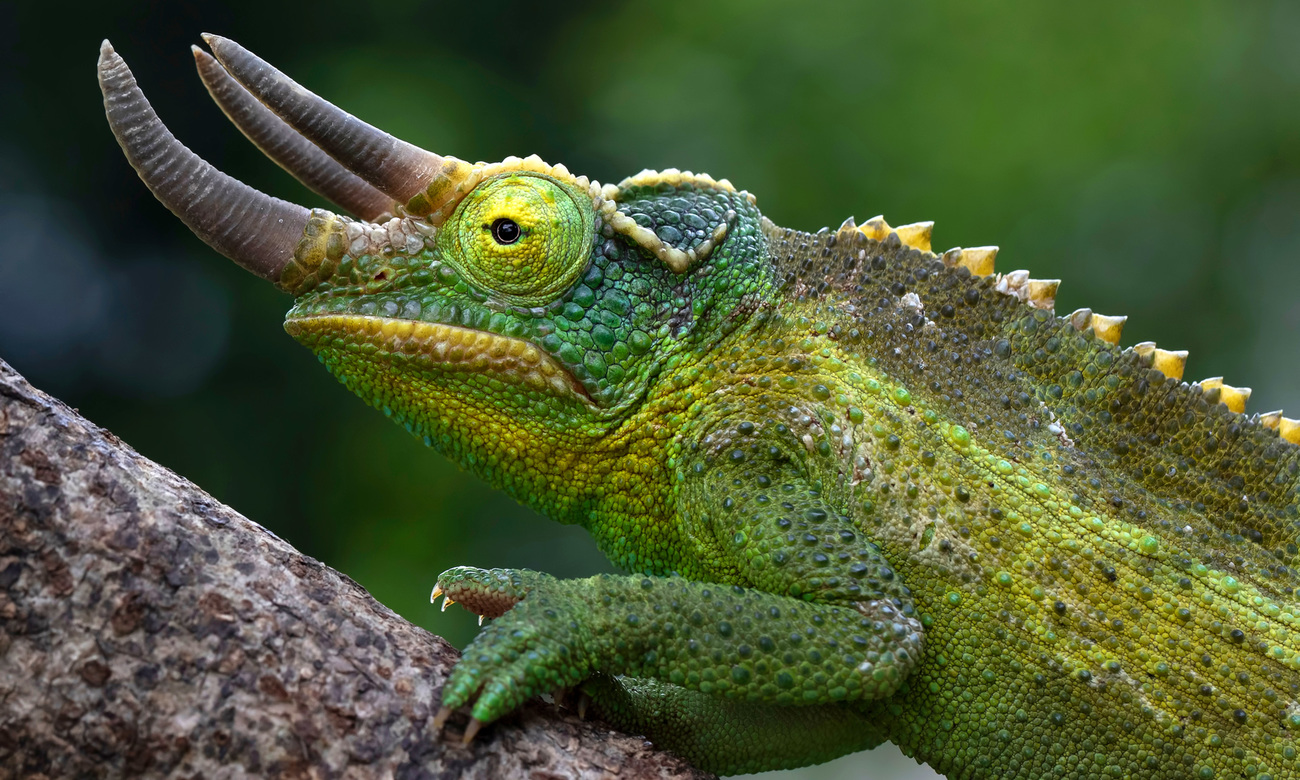
Jackson’s chameleon (Trioceros jacksonii) is a reptile found in Kenya and Tanzania. They have more horns than any other animal on this list, as they have three—one above their nose and two above their eyes—which makes them resemble the triceratops. Only male chameleons have horns, but females sometimes have traces of the central horn. These animals are typically bright green, but like all chameleons, they can change colour depending on factors like temperature, health, and their need to blend into their surroundings.
The IUCN classes Jackson’s chameleon as least concern. However, they are threatened by the exotic pet trade, as they have been reported to be one of the most exported chameleon species.
Want to help protect these amazing animals in Africa and others around the world? Consider supporting IFAW’s conservation and rescue work.
every problem has a solution, every solution needs support.
The problems we face are urgent, complicated, and resistant to change. Real solutions demand creativity, hard work, and involvement from people like you.
Unfortunately, the browser you use is outdated and does not allow you to display the site correctly. Please install any of the modern browsers, for example:
Google Chrome Firefox Safari